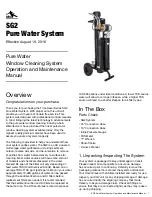
ENGLISH
GB
68
drained, the salts dissolved in the water could have settled and formed
calcification between the moving part (motor shaft) and the fixed part of
the pump, thus increasing the resistance on starting. In this case it may be
sufficient to help the motor shaft by hand to detach itself from the calcifica
-
tions. In this system the operation is possible because access to the motor
shaft from outside is guaranteed and a groove is provided at the end of the
shaft. Proceed as follows:
1. remove the cover of the technical compartment (fig.1 Face A);
2. lift the rubber cover of the motor shaft access cap (fig. 22);
3. using a 10mm hexagonal key, remove the motor shaft access cap
(fig. 22);
4. insert a straight tip screwdriver in the groove on the motor shaft and
manoeuvre, turning in 2 directions (fig. 22);
5. if it is turning freely the system can be started, after having replaced
the cap and cover that have been removed;
6. if rotation is blocked and it cannot be removed by hand, call the as
-
sistance service.
Should one or more O-rings be lost or damaged during mainte
-
nance operations on the non-return valve, they must be replaced.
Otherwise the system might not work correctly.
9.4 - Motor shaft
The electronic control of the system ensures smooth starts so as to avoid
excessive stress on the mechanical parts and thus prolong the life of the
product. In exceptional cases this characteristic could cause problems
in starting the pump: after a period of inactivity, perhaps with the system
Figure 21
Figure 22




































